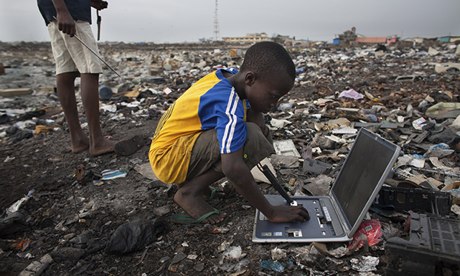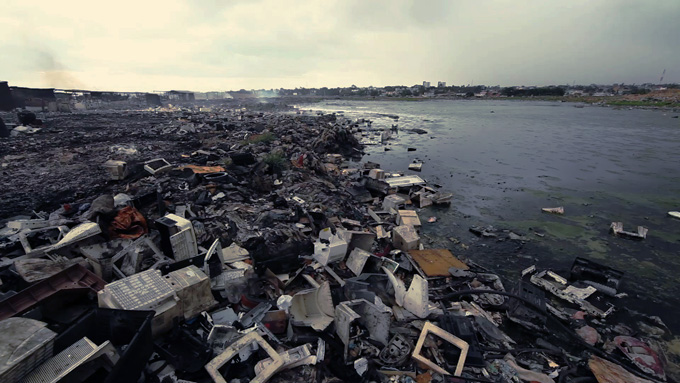Most North Americans do not experience waste first-hand beyond their own garbage cans. When waste is conveniently taken away for disposal each week, few consumers consider where, exactly, their waste goes, why it goes there, who is affected, and whether this practice can be sustained. The increasing use of synthetic materials, the emergence of a “throw away” society, the difficulty of fixing broken products, the use of more extensive packaging, and the increasing obsolescence of technologies have encouraged consumers in the North to buy more. This overconsumption has exhausted the waste-sink capacity (that is, the capacity of the Earth to absorb wastes in a way that is safe, fair and sustainable) of lands in North America, causing municipal governments and waste disposal companies to search elsewhere for places for the wastes to be disposed of. The export of wastes to developing countries became a thriving business in the 1980s and 1990s; today, wastes from the North are travelling longer distances to poorer, less-industrialized countries, creating the illusion that there are enough places for the wastes to go. While, for the time being, this issue largely simmers beneath the surface of international relations, it is clear that this particular form of environmental injustice will only become more visible as time goes on.
The global trade of “e-waste” is particularly dangerous to the developing world as it contains high levels of toxins and other hazardous materials.
One of the most famous examples of waste distancing is the voyage of the Khian Sea, a Norwegian ship registered in Liberia that sailed from the United States in 1986 carrying nearly fourteen thousand tons of toxic incinerator ash from a Philadelphia municipal waste facility. The ship sailed to various ports in the global South for over two years, searching to no avail for a country willing to accept and dispose of its toxic cargo. After months of searching, the ship was authorized to unload its cargo in Haiti, as the Haitian government was made to believe that the ash was merely fertilizer. When the government became aware of the Khian Sea’s scheme, it ordered for the waste to be removed. The ship left Haiti to continue its search, but reportedly left behind an estimated four thousand tons of ash on a beach. As the ship made its way through the Middle East and East Asia, environmental groups and the media began to widely publicize the voyage, ensuring that no government would accept the toxic ash. The ash mysteriously disappeared from the ship in Southeast Asia, causing many to believe that the ash was dumped at sea. The example of the Khian Sea demonstrates that environmental injustices operate on a global scale, as all of the ports at which the vessel attempted to dispose of the toxic ash were located in the global South.

An added challenge to the already severe problem of waste distancing is the ever-increasing amount of electronic waste being disposed of by consumers in the North each year. According to Environment Canada, Canadians dispose of 140,000 tonnes of computer equipment, phones, televisions, stereos, and small home appliances annually – enough to fill the Toronto Rogers Centre each year for the next fifteen years. The global trade of “e-waste” is particularly dangerous to the developing world as it contains high levels of toxins and other hazardous materials. At the e-waste processing plant in Guiyu, China – which is often referred to as the e-waste capital of the word – nearly 150,000 workers disassemble old computers, TVs and iPhones before burning or dissolving the parts in acid to extract the precious metals housed within. Many workers do their jobs without protective clothing and pollution has taken a severe toll on human health and the environment. For example, a 2010 study showed that 88 percent of children living in Guiyu tested positive for lead poisoning. Similarly, in the Agbogbloshie e-waste dump near Accra, Ghana, millions of tonnes of e-waste from industrialized countries are processed by workers with no safety equipment each year. This led to high levels of toxins in the soil, water and air, contaminated food supplies, respiratory illness and lead poisoning.

In response to these issues, the United Nations Basel Convention sought to provide a solution to the distancing of waste from developed to developing countries. However, the Convention has been heavily criticized, due to a number of pitfalls inherent in the treaty. Perhaps the most critical of these pitfalls was the loophole which allowed the distancing of wastes from developed to developing countries for the purposes of recycling; as a result of this, the global waste trade did not cease to exist as the Basel Convention intended – it simply evolved into a global waste-for-recycling trade that is arguably just as detrimental to human health and the environment as the trading of wastes for disposal. Subsequently, developing countries and ENGOs advocated an outright ban on the distancing of waste, which led to the drafting of the Basel Ban Amendment. In response to the amendment, developed countries – and several developing countries – expressed concerns regarding the loss of revenue if a total ban was placed on the distancing of waste. As a result, the Amendment has still not been ratified by enough countries to bring it into legal force.
Such concerns over loss of revenue perpetuate the false perception that poor countries in the global South are obligated to accept wastes and the jobs that accompany them because they supposedly have no other option. The choice between no jobs and no development versus low-paying, risky jobs and pollution is not only a false dichotomy, it is, as many environmental justice scholars have put it, environmental blackmail. Community engagement, grassroots movements and international pressure can constitute an important first step towards safer, more sustainable practices of waste disposal and recycling as well as stronger protections and better working conditions for waste workers in the global South.




